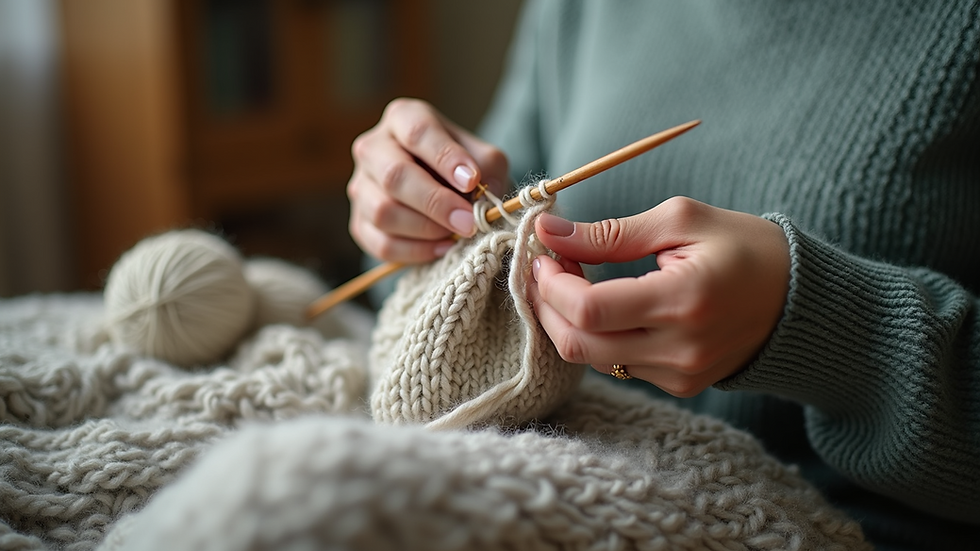Master the Art of Knitting with Our Expert Tips
- Jul 19
- 4 min read
Knitting is more than just a hobby; it’s an art form that can transform yarn into beautiful creations. Whether you are just beginning your journey or looking to refine your skills, mastering knitting techniques is essential. This article will provide you with expert tips to enhance your knitting, introduce you to basic concepts, and inspire your creativity.
Knitting Techniques
Understanding the different knitting techniques is key to becoming a successful knitter. Here are some essential techniques that every knitter should master:
1. The Basics of Knitting
Before diving into more complex patterns, it’s essential to grasp the fundamental techniques. Start with the basic knit and purl stitches. The knit stitch creates a smooth texture, while the purl stitch gives a bumpy surface. These two stitches form the foundation of most knitting patterns.
To practice, cast on 20 stitches and alternate between knit and purl for several rows. This will help you become comfortable with the motions of knitting and purling.

2. Understanding Yarn Types
Not all yarns are created equal. They come in various weights, textures, and fibers. Choosing the right yarn is crucial depending on the project you’re working on. Here are some popular types:
Acrylic: Affordable and widely available, perfect for beginners.
Wool: Offers warmth and elasticity, great for clothing items.
Cotton: Breathable and perfect for dishcloths and summer garments.
When choosing yarn, consider the project’s purpose and season. Light yarns are excellent for summer items, while thicker yarns work best for winter wear.
What is knit in synonyms?
In the context of crafting and textiles, "knit" can be described with several synonyms. Some of the most common include:
Weave: A method that interlaces yarns to create fabric.
Stitch: The individual loop that connects and forms a knitted pattern.
Craft: The overall skill involved in executing projects, including knitting.
These synonyms highlight the technique and artistry involved in the process of knitting.
3. Gauge Matters
Gauge refers to the number of stitches and rows per inch in a finished project. This is a crucial aspect of knitting that affects the fit and final appearance of your work. Always check your gauge before starting a project, especially if you are following a pattern.
To determine your gauge, knit a square swatch of at least 4 inches by 4 inches using the yarn and needles you plan to use. Measure your stitches and rows; if they don’t match the required gauge in your pattern, adjust your needle size. This simple step can save you from future frustrations.

4. Mastering Different Cast-On Techniques
The cast-on technique determines how your project begins. There are various cast-on methods, each resulting in a different edge. Here are a few popular ones:
Long Tail Cast-On: A versatile method used for most projects.
Slingshot Cast-On: A great option for knitting in-the-round.
Cable Cast-On: Yields a firm edge, perfect for projects needing a strong base.
Experiment with different cast-on methods to discover which one you prefer. Your chosen method can greatly influence the drape and appearance of the final product.
5. Finishing Techniques
After you've completed your project, take time to finish it properly. This includes weaving in loose ends, blocking your work, and adding any necessary embellishments. Here are essential tips for finishing:
Weaving in Ends: Use a yarn needle to weave in any tails left from joining new skeins or changing colors. This helps ensure your project looks polished.
Blocking: This process involves wetting your item and shaping it to its final dimensions. It enhances the overall appearance and evens out stitches.
Embroidery and Embellishments: Consider adding embroidery, buttons, or other decorative elements to give your finished project a personalized touch.

Building Your Knitting Community
Knitting doesn’t have to be a solitary craft. Connecting with other knitters can provide motivation and inspiration. Here’s how you can build your knitting community:
1. Join a Local Group
Many communities have knitting clubs or groups where enthusiasts meet to share techniques and work on projects together. This social aspect encourages learning and provides mentorship for beginners. Purls n' Potions meets up Sundays in Littleton, CO - if interested, please message me!
2. Participate in Online Forums
Online platforms offer vast resources for knitters. Websites, forums, and social media groups allow knitters from around the globe to exchange tips and provide support. Check out our Members at www.purlsnpotions.com to get exclusive offers, share ideas and gain points with our Loyalty program for every purchase!
3. Attend Knitting Workshops
Look for local workshops in your area. Many yarn shops host classes for all skill levels. These workshops can introduce you to new techniques and provide invaluable hands-on experience.
Embrace the Journey of Knitting
Knitting is not just about the end product; it’s about the journey. Whether you want to create cozy garments, intricate lacework, or delightful gifts, the skills you develop will serve you throughout your crafting journey. Remember to be patient with yourself — every expert was once a beginner.
To truly embrace and master the art of knitting, incorporate these expert tips into your routine. Don’t shy away from challenges, and always seek ways to learn and improve. With dedication and practice, you will transform simple yarn into stunning creations.
For more in-depth insights about knitting techniques and projects, feel free to explore our blog where we share numerous resources to inspire your journey. Happy knitting!




Comments